1. E-mails from Andrey,
March 24/25, 2009 – (summary).
I am not sure as to
your address and in what language to write? I am engaged in
the genealogy of the family and have found
your site. In your family tree you have Albert Karol Herman and you
mention Kharkov. Still 3 years ago I knew nothing about my ancestors.
I live in Kharkov and recently have found four surnames which are
related to me: Link,
Rangenau, Liebelt,
Kuhndt
and originate from the Evangelical-Augsburg
Parafia Wiskitki-Zirardow. They
have been deported in 1915 to Kharkov, and from the history of
Parafia Zirardow
I know that 64 families have been deported (…) into the depth of
Russia, far away from a front line, as the unreliable German
population. Families Kuhndt,
Liebelt, Rangenau
and Link got to Kharkov.
After the end
of First World War, approximately in
1921-23 they have returned home in Жирардов,
but my grandfather and father Jury Link - which is my godfather, were
not let out from Kharkov because of the military duty obligation (обязанныe).
That all others have returned during this period in
Жирардов, I judge by the date of Metrics
delivery a birth of my grandfather.
My Mum became orphan
early at the age of 8 years - my grandmother, that is her mother, has
died in 1937 and the father, or my grandfather -
Ludwih
Liebelt (1899 - year of his
birth) was subjected to
repression by Stalin and has been shot in 1938, ostensibly as the
German and Polish spy.
On
your site I read the information that you happened to visit
Wiskitki and Zirardow.
Perhaps you have some more information?
Andrey
2. Community of Żyrardów
– (summary)
(translation from German text – Eduard Kneifel: Die
evangelisch-augsburgischen
Gemeinden in Polen 1555-1939; S. 48. GEMEINDE ZYRARDOW.)
Circa the year
1800 Evangelical Germans settled in or around
Wiskitki.
Count Feliks
von Lubieński, owner of the properties in Guzów (see map)
established 11 German villages: Antoniew, Babsche Buden (Babskie
Budy?), Bieganów, Felixdorf (Feliksów?), Francisków (Franciszków),
Heinrichsdorf (Henryszew?), Josefhof (Jozefow?),
Marienfeld (Mariampol?), Moritzin (Maurycew?), Teklin
and Zader-Buden (Sade Budy?).
During
1807-1815 new settlements were established in Aleksandria i
Benenard, which were most probably founded by a French Captain.
The colonists
came primarily from West Prussia, Brandenburg and Silesia (Schlesien).
Initially, the
religious care was provided by Fr. Witthold from Iłów. … In
1805 a parish was organized in Wiskitki – it included 180
families. The Parish house burned down in 1822 … the parish
priests were changing frequently … during 1836-1855 the
Wiskitki parish was administered from (the town of) Łowicz
(it was a “Filial” [a branch] of the Parish in Łowicz). In
1855 the Parish became again independent … In 1872 a Filial
(branch) in Karolew was included with Wiskitki. The
pastor from Wiskitki visited four times a year the town of
Błonie.
The
establishment of the factory settlement in Żyrardow was
important for further development of the Parish. In 1833,
mechanical weaving machines, recently invented by a French engineer
Phillip Gerard, were brought to Guzów on the river Pisia
from Marymont near Warsaw. … New settlement was established, which was
named Żyrardów – to honor the inventor. There were some difficulties
with its development in spite of the financial and credit assistance
from the Polish Bank. In 1856, the Company hired Karl August
Dittrich and Eduard Hille, who were German Catholic industrialist from
Schoenlinde in Bohemia (Boehmen) … The factory attracted
workers from the German villages. … In 1890, already 1900
Evangelicals resided in Zyrardow – the religious services from the 6
km distant Parish in Wiskitki were not adequate for them. …
On the
initiative of (the Pastor Gustav Gundlach, 1889- 1898), a beautiful
gothic church was built at a cost of ca. 50 000 Rbl.. Dittrich
contributed 20 000 Rbl. The church was dedicated on September 25,
1898
by the Gen.-Sup. Manitius.
… Due to the construction of the church, center of the Community
shifted to Żyrardów. … Intensified emigration to the USA diminished
the number of members. The Russian-Japanese war and the subsequent
Revolution also had a negative influence on the life of the Community.
Resulting from
the World War I, only 300 remained from the earlier 4 500 members of
the Parish. … Pastor Wosch administered the Żyrardów Parish.…(Some)
deportees to Russia returned in 1918. …
A French Company took over the Żyrardów factory …
(with a
resulting negative effect on the German community. Next, it follows
the description of the inter-war activities).
3/ E-mail,
April, 06, 2009 10:44 PM
Leitner factory – Albert Herman -
Hello Waldemar!
I think it will
be interesting to you!!!
On July 10th,
1915 the A.Lejtner's bicycle factory in Riga has received an order to
evacuate from Riga to Kharkov, as German armies already approached
Riga. The factory received an order from the Main Military -Technical
Management (ГВТУ) of the Russian army on delivery of military bicycles
and detonators for grenades. On September, 24th, 1915 the property and
the equipment "Factories of bicycles and A. Lejtner's cars and Co."
have been sent from station Revel in several tens of cars to Kharkov.
After that Alexander Aleksandrovich Lejtner has returned to Riga where
there was a real estate in the form of a complex of factory cases. To
fulfil duties of the director in Kharkov there was Alexander
Kasparovich Feldman managing manufacture.
Approximately
at the same time, "Dux" receives the large military order for
manufacture of airplanes and hydroplanes. Bicycle manufacture pales
into insignificance, as almost all capacities have been reoriented on
aviamanufacture. The matter is that at this moment the factory
remained the unique domestic supplier of aircraft for front.
On February,
9th, 1916 to Kharkov, addressed to Лейтнера (Leitner) from Moscow, was
the patent, with the engineering specifications and the sample for
manufacture of a collapsible military bicycle of model "Dux Boevoj" of
M. M. Shchipanov design, have been transferred.
The front
demanded the increasing quantity of велотехники (velocypeds –
bicycles) and in ГВТУ the decision was accepted, (with the consent of
administration of "Dux" and M.M. ShChipanova), that both largest
bicycle enterprises of the country will make “the Boyevoy – the
Fighting"
Payment to the
inventor of the established sum from each collected bicycle or a frame
was a condition of transfer of the patent. On March, 16th the contract
on manufacturing 3000 "Duksov Boevyh" for ГВТУ has been concluded.
__________
*
http://www.ctrl-c.liu.se/misc/ram/dux.html. Based on former
bicycle factory in Moscow, Dux (owned by Yu.A.Meller) was the the
largest manufacturer of aircraft in Russia during WWI (1733 built).
F.E.Moska was a designer in the factory. Most aircraft were just
copies of French aircraft built with (and without, too) license. For
example, Dux-monoplane 1912 was identical to Neuport-IV, while Dux-3
differed only by transparent panels in fuselage. Presented are some 'semi-original'
models, including significant changes. After October revolution Dux
was financed by Bolshevik government following personal order of
V.I.Lenin. August 1918 : N.N.Polikarpov became the Technical Division
Supervisor on the factory. His division carried out all design,
drawing, copying jobs as well as material tests. Production achieved
up to one aircraft/day. End of 1918 - started production of the R-1/D.H.-4.
The first designer's achievement of N.N.Polikarpov.
4/ The
History of the Folding Bike –
http://www.foldingcyclist.com/folding-bike-history.html
Several countries used folding
bikes in their military and there were many manufacturers of them
starting in the 1890's such as Dursley-Pedersen (England), Faun
(England),
Fongers (Holland), Peugeot (France),
Bianchi (Italy),
Leitner (Russia), among others. The most prominent of the military
bicycle manufacturers was notably the English company BSA (Birmingham
Small Arms). They produced folding bikes by the thousands for WWI and
WWII. (...)
Leitner’s folding bike

Map of Riga, 1916
http://www.1201.lv/maps/1916/
16/18, Mostovaya str. (currently Tilta yela) -
registered here on Nov.10, 1909
3, Siemionowskaya str. (currently Simanju yela) - registered here Feb.
3, 1910
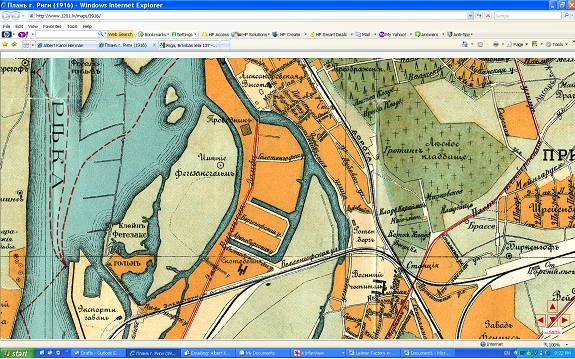
5, Gospitalnaja str., (Hospitalu iela), apt.# 32 - last address of
Albert and Aniela in Ryga;
Leutner's Factory - 129-131, Alexandrovska (currently 137,
Brivibas iela) -
Завод велосипедов Лейтнер и К- ул.Александровская 129-131

Localization of the Leitner's (Leutner's) Factory on the contemporary
map of Riga (A) -
to the left and above is Hospitalu iela
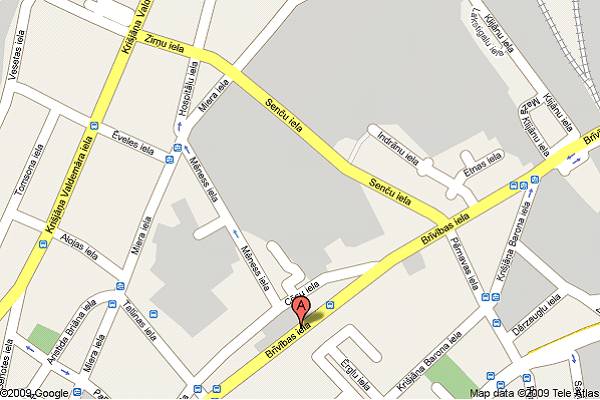
The photos of the Leitner (Leutner) factory
in Riga
1886 and 1910
http://rigatransport.sitecity.ru/ltext_0911224307.phtml?p_ident=ltext_0911224307.p_1508142720
Cointemporary Photos
Map of Kharkov, 1887
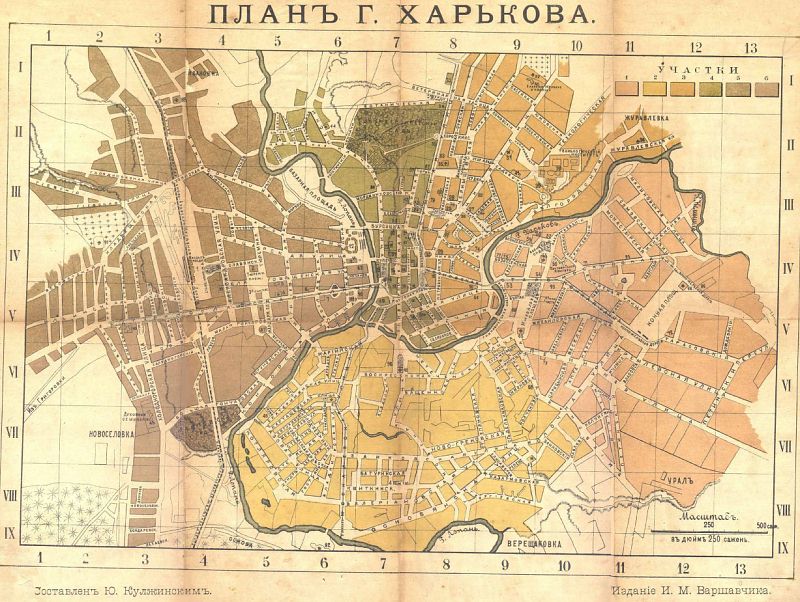
Map fragment – Caritsinskaya street
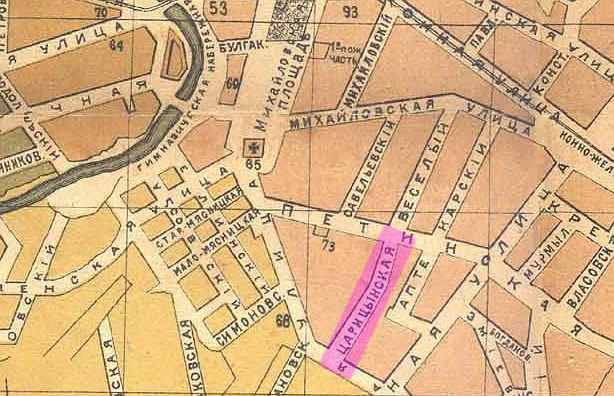
Recent Russian Post Stamp
Date of Issue 11 December 2008
Bicycles - Collapsible military model bicycle "Leitner",
1917
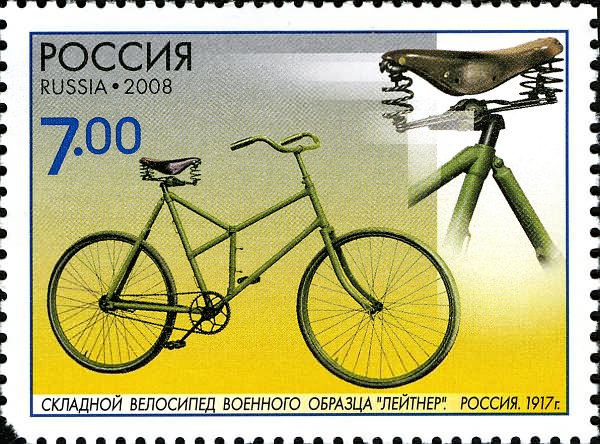
-
Russian Bicycle Factory of Alexander A. Leitner
The folding military bicycle “Leitner” from the
collection of the Polytechnical Museum is a unique example of the
Russian pre-revolutionary technology. It was produced in Riga in the
factory of bicycles and automobiles “Russia” owned by Alexander
Alexandrovich Leitner, who was a pioneer in the production of bicycles
in our country. The factory started production in 1886 and at the
beginning of the XX. century became a solid enterprise, comparable in
size to the majority of European companies.
Leitner’s products distinguished themselves by high quality and
dependability, which assured the company high success in entire Russia.
The owner, Alexander A. Leitner was not only a well educated and
talented businessman, but also a prominent constructor and inventor.
Leitner’s factory started producing the folding military bicycles
during the years of WW-I, from February until November 1917, already
at the time of its relocation from Riga to Kharkov. It is interesting
to know that the technical drawings of the folding bicycle were
developed in the Moscow enterprise “Dux” belonging to J.A Meller and
were based on the best models of the bicycle developed in the country.
“Dux” was also producing bicycles, but in 1917 it was forced to stop
their production and to switch to building the aeroplanes. At that
time, it sold the entire documentation to the Leitner’s factory.
The bicycles were produced at the request from the Russian Army and
had to fulfill several requirements: they should be light, durable,
uncomplicated in use and service and allow rapid folding. It can be
said that, while achieving these parameters, our domestic model
exceeded other foreign ones in military use such as: French bicycle
“Peugeot” designed by captain Gerard and also Austrian, German and
Japanese models.
Folding mechanism based on the rifle lock design allowed rapid folding
in all kinds of circumstances. The same functions performed in
analogous foreign models required markedly more time.
Comfortable and low frame of the Leitner’s bike allowed the soldier to
shoot while standing up, without the necessity to dismount the bike
and its light weight, only 16 kg, allowed transporting, if needed, on
the back while fastening the bike with a leather strap attached to its
back wheel. Equipping the Russian Army with bicycles of domestic
production and the existence of an appropriate base for their
production allowed to avoid purchasing this technology from abroad and
also to save millions of rubles, what was of extreme importance in
those difficult times.
The bicycle from the collection of the Polytechnical Museum is the
only surviving complete example of a device produced in the Leitner’s
Factory. It can undoubtedly stand in the same row with the best
accomplishments of the military bicycle production in the world, what
can be easily noticed by every visitor to the Museum.
T. L. Ochlopkova
-
Lejtner (Leutner) Factory in Riga
(E-mail from
Andrey Shałamov – Sept. 25, 2009)
A factory of an enterpreneur Alexander
Alexandrovich Lejtner (Leutner) has been established in Riga in 1886.
Originally it was a small rented workshop at Gertrudinsky street,
where three workers assembled bicycles of a type "Spider". Gradually
the enterprise enlarged. The number of workers increased, necessary
machines and tools were obtained and a new building at Suvorovsky
street has been rented.
On July 1, 1897 the “association on belief” (the Russian variant of a
joint-stock company) "Factory of bicycles ‘Russia’ of A. Lejtner and
Co" with the authorised capital of 100,000 roubles has been founded.
Alexander Lejtner was a chairman of the association and the manager of
credits. 194 persons worked at that time at the enterprise, there was
a magnificent park of 200 machines and over 1,000 bicycles were
produced in a year.
At the beginning of the XX-th century Lejtner took large loans in
banks, for building of a new factory, which was secured by the
previously purchased land parcel at the Aleksandrovsky street, Nr
129/131. The whole complex of brick three-story buildings in the form
of a quadrangle has been constructed, containing the workshops,
warehouses for materials and finished goods, galvanic shop, a smithy,
shop, a showroom and other premises. An office building, with a facade
facing the Aleksandrovsky street, was crowned with a weather vane in
the form of a bicycle. (By the way, the whole complex of buildings of
the factory survived until now, including the weather vane.)
In 1914 the factory receives the new name – “Lejtner”. Alexander
Aleksandrovich felt that he does not need anymore the name "Russia" to
attract the buyers – the products of his factory became already known
all over the country. He had the full right to give his own name to
the factory - after all it was entirely his child.
During the 31 years of its existence “The Factory of Bicycles and Cars
‘Russia’ of A. Lejtner and Co.” progressed from a small handicraft
workshop to the enterprise, which was largest in its specialty. In
this time more than 100,000 bicycles of 60 models were produced, 5
models of motorcycles and tricycles along with some models of cars.
T.Ł.Ochłopkowa